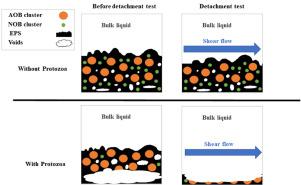Water Research ( IF 11.4 ) Pub Date : 2021-11-30 , DOI: 10.1016/j.watres.2021.117911 B Kim 1 , R Nerenberg 1

|
This research explored the effects of eukaryotic predation on nitrifying membrane-aerated biofilm reactor (MABR) biofilms. Past research on heterotrophic MABR biofilms showed that predation could create internal voids that promoted sloughing. However, the no past research addressed the effects of predation on nitrifying MABRs, even though nitrification is the most common MABR application. Nitrifying biofilms are typically denser, and ammonia oxidizing bacteria (AOB) form large, dense clusters within the biofilm. This could affect their susceptibility to predation. Nitrifying biofilms were grown in flat-sheet MABRs. Images of the biofilm were captured using optical coherence tomography (OCT). For detachment tests, an increased shear flow (Re≅140) was used, and a shear rheometer was used to measure the biofilm mechanical properties. The nitrifying community was analyzed with fluorescence in situ hybridization (FISH) and quantitative PCR (qPCR). Predation increased internal void ratios from 54 ± 5% to 69 ± 6%. Biofilms were weakened by predation, with a storage modulus (G′) and loss modulus (G′′) of 242 ± 135 and 1,649 ± 853 Pa with predation and 3,644 ± 1,857 and 23,334 ± 11,481 Pa for the control with suppressed predation. Predation increased the relative biofilm detachment from 4 ± 5 to 18 ± 12%, decreased the amount of biomass, i.e., the average biofilm thickness, from 502 ± 150 to 266 ± 54 µm, and decreased the nitrification flux from 1.00 to 0.61 g NH4+-N/m2day. Also, predation decreased the abundance of nitrite oxidizing bacteria (NOB) relative to AOB, consistent with the observed nitritation. These results show that predation can significantly impact the structural stability, bacterial community and removal rates of nitrifying MABR biofilms. Lumping the effects of predation into the detachment or decay coefficients of biofilm models may not accurately reflect the behavior of nitrifying MABR biofilms.
中文翻译:

真核生物捕食对硝化 MABR 生物膜的影响
本研究探讨了真核生物捕食对硝化膜曝气生物膜反应器(MABR)生物膜的影响。过去对异养 MABR 生物膜的研究表明,捕食可能会产生促进脱落的内部空隙。然而,尽管硝化是最常见的 MABR 应用,但过去没有研究探讨捕食对硝化 MABR 的影响。硝化生物膜通常较致密,氨氧化细菌 (AOB) 在生物膜内形成大而致密的簇。这可能会影响它们对被捕食的敏感性。硝化生物膜在平板 MABR 中生长。使用光学相干断层扫描(OCT)捕获生物膜的图像。对于分离测试,使用增加的剪切流( Re≅140 ),并使用剪切流变仪测量生物膜的机械性能。通过荧光原位杂交 (FISH) 和定量 PCR (qPCR) 分析硝化群落。捕食使内部空隙率从 54 ± 5% 增加到 69 ± 6%。生物膜因捕食而减弱,捕食时的储能模量 (G') 和损耗模量 (G'') 分别为 242 ± 135 和 1,649 ± 853 Pa,捕食受到抑制时的对照为 3,644 ± 1,857 和 23,334 ± 11,481 Pa。捕食使相对生物膜脱离率从 4 ± 5% 增加到 18 ± 12%,生物量(即平均生物膜厚度)从 502 ± 150 µm 减少到 266 ± 54 µm,硝化通量从 1.00 g NH 减少到 0.61 g NH 4 + -N/m 2天。此外,相对于 AOB,捕食降低了亚硝酸盐氧化细菌 (NOB) 的丰度,这与观察到的亚硝化作用一致。 这些结果表明捕食可以显着影响硝化 MABR 生物膜的结构稳定性、细菌群落和去除率。将捕食的影响集中到生物膜模型的脱离或腐烂系数中可能无法准确反映硝化 MABR 生物膜的行为。











































 京公网安备 11010802027423号
京公网安备 11010802027423号